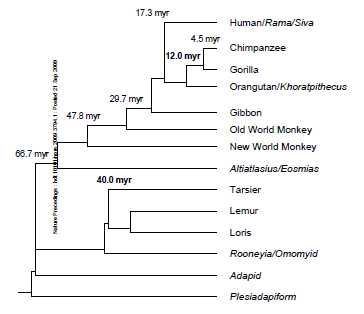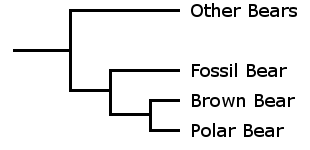
Unravelling the Evidence
Specimens:
Studying the how modern life
evolved is terribly difficult. This is mainly because we need to know
what happened in the distant past, and to do that we must rely on the fossil
record. Unfortunately fossilization requires very specific conditions
before it can occur: based on the average chance of fossilization, the current
human population of the USA (around 300 million) would produce just 50 fossil
bones! In reality what we really see is
that most rock is bare of fossils, but a choice few beds formed in the perfect
conditions for fossilization, and here we find many well preserved specimens
Evolution by natural and sexual selection results in a hierarchy of common ancestors, meaning that every organism is related to some degree. This gives rise to the well known 'tree of life' that can be drawn to show the relationships between any chosen organisms. Modern methods often use molecular data to draw these trees (known as phylogenetic trees), but this is not usually possible with extinct organisms as the soft tissue containing this data almost always decays over time.
A recently published phylogenetic tree for primates, based on molecular data.
'myr' marks show how long ago the respective junction was, in million years
Now imagine taking this to a much larger level and looking at two different species – brown bears and polar bears for instance – it is impossible to know exactly which long dead organism was the last common ancestor. We may have fossil bears that share features with the brown bear and the polar bear, but with no other bears, so we can say these fossils are closer to the brown and polar bear than any other bear. But there is no way we can know if this fossil is the last common ancestor, and in reality it is highly unlikely that out of the potentially thousands of similar bears that the last common ancestor is the one of the few that fossilized. Instead we would add the fossil bear species onto the phylogenetic tree between the polar/brown junction and the rest of the bear family, like this:
As you can
see, the quest for ‘missing links’ is unlikely to find the ‘links’ themselves,
but will simply add more branches into the tree. However, this is still a valuable process,
the fossil bear after all would provide an insight into the common ancestry of
the polar and brown bear even if it is unlikely to be the ancestor itself. The fact it is a fossil, and its sharing of
characteristics, would place this bear as a basal
member of the small group illustrated above, while the brown and polar bear
would be called more derived members.

